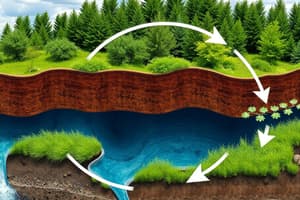Podcast
Questions and Answers
Which of the following processes is NOT a major pathway in the nitrogen cycle?
Which of the following processes is NOT a major pathway in the nitrogen cycle?
- Nitrification
- Denitrification
- Condensation (correct)
- Assimilation
How do oceans primarily regulate carbon dioxide levels in the atmosphere?
How do oceans primarily regulate carbon dioxide levels in the atmosphere?
- Through the process of nitrogen fixation.
- By converting carbon dioxide into fossil fuels.
- By storing carbon as bicarbonate mineral deposits.
- Through direct carbon dioxide exchange. (correct)
What role do green plants play in the carbon cycle?
What role do green plants play in the carbon cycle?
- They release carbon dioxide through respiration.
- They decompose organic waste into carbon dioxide.
- They take up carbon dioxide for photosynthesis. (correct)
- They convert carbon into fossil fuels.
Which process involves the change of snow or ice directly into water vapor?
Which process involves the change of snow or ice directly into water vapor?
What is the term for water vapor cooling down in the atmosphere and forming tiny droplets of water or ice?
What is the term for water vapor cooling down in the atmosphere and forming tiny droplets of water or ice?
What is the process called by which precipitated water is absorbed into the ground?
What is the process called by which precipitated water is absorbed into the ground?
Which of the following is an example of an abiotic factor in an ecosystem?
Which of the following is an example of an abiotic factor in an ecosystem?
Which of the following is considered a biotic factor?
Which of the following is considered a biotic factor?
What is the term for ecological factors related to soil structure, soil types, and topography?
What is the term for ecological factors related to soil structure, soil types, and topography?
What instrument is used to measure the degree of coldness or hotness of a body?
What instrument is used to measure the degree of coldness or hotness of a body?
What instrument is used to measure the amount of rainfall?
What instrument is used to measure the amount of rainfall?
Which instrument is used to measure light intensity?
Which instrument is used to measure light intensity?
What instrument is used to measure relative humidity?
What instrument is used to measure relative humidity?
Which instrument indicates the direction of the wind?
Which instrument indicates the direction of the wind?
Which instrument measures the speed of the wind?
Which instrument measures the speed of the wind?
What does a barometer measure?
What does a barometer measure?
What is measured using a Secchi disc?
What is measured using a Secchi disc?
What is the function of assimilation in the nitrogen cycle?
What is the function of assimilation in the nitrogen cycle?
How does deforestation impact the carbon cycle?
How does deforestation impact the carbon cycle?
What is the primary role of decomposers in nutrient cycles?
What is the primary role of decomposers in nutrient cycles?
How does wind influence habitats?
How does wind influence habitats?
Why is the carbon cycle considered complex?
Why is the carbon cycle considered complex?
Which process in the water cycle directly contributes to the formation of clouds?
Which process in the water cycle directly contributes to the formation of clouds?
Which of the following activities releases carbon dioxide back into the atmosphere?
Which of the following activities releases carbon dioxide back into the atmosphere?
How does temperature affect the distribution of organisms?
How does temperature affect the distribution of organisms?
What is the role of nitrogen fixation in the nitrogen cycle?
What is the role of nitrogen fixation in the nitrogen cycle?
Oceans store carbon as what type of mineral deposit?
Oceans store carbon as what type of mineral deposit?
Transpiration, surface water evaporation, and sublimation contribute to the presence of water in which sphere?
Transpiration, surface water evaporation, and sublimation contribute to the presence of water in which sphere?
How can you accurately measure the ecological factor related to Air Pressure?
How can you accurately measure the ecological factor related to Air Pressure?
Flashcards
What is Nitrogen Fixation?
What is Nitrogen Fixation?
The process where atmospheric nitrogen is converted into ammonia.
What is Nitrification?
What is Nitrification?
The biological oxidation of ammonia or ammonium to nitrite followed by the oxidation of nitrite to nitrate.
What is Ammonification?
What is Ammonification?
The conversion of organic nitrogen into ammonia.
What is Assimilation?
What is Assimilation?
Signup and view all the flashcards
What is Denitrification?
What is Denitrification?
Signup and view all the flashcards
What is the Carbon Cycle?
What is the Carbon Cycle?
Signup and view all the flashcards
What is Evaporation?
What is Evaporation?
Signup and view all the flashcards
What is Sublimation?
What is Sublimation?
Signup and view all the flashcards
What is Condensation?
What is Condensation?
Signup and view all the flashcards
What is Precipitation?
What is Precipitation?
Signup and view all the flashcards
What is Infiltration (Percolation)?
What is Infiltration (Percolation)?
Signup and view all the flashcards
What is Runoff?
What is Runoff?
Signup and view all the flashcards
What are Biotic Factors?
What are Biotic Factors?
Signup and view all the flashcards
What are Abiotic Factors?
What are Abiotic Factors?
Signup and view all the flashcards
What are Edaphic Factors?
What are Edaphic Factors?
Signup and view all the flashcards
What are Physical Factors?
What are Physical Factors?
Signup and view all the flashcards
What is Temperature?
What is Temperature?
Signup and view all the flashcards
What is Rainfall?
What is Rainfall?
Signup and view all the flashcards
Source of Light in an Ecosystem
Source of Light in an Ecosystem
Signup and view all the flashcards
What is Humidity?
What is Humidity?
Signup and view all the flashcards
What is a Photometer?
What is a Photometer?
Signup and view all the flashcards
What is an Anemometer?
What is an Anemometer?
Signup and view all the flashcards
What is a Wind Vane?
What is a Wind Vane?
Signup and view all the flashcards
What is Pressure?
What is Pressure?
Signup and view all the flashcards
What is Turbidity?
What is Turbidity?
Signup and view all the flashcards
Study Notes
- Nutrient flow occurs in an ecosystem
Nitrogen Cycle
- Major pathways include: nitrogen fixation, nitrification, ammonification, assimilation, and denitrification
Carbon Cycle
- The carbon cycle is the movement of carbon from the atmosphere into organisms and back
- The carbon cycle can exist in different compounds in plants, animals, rocks, liquids, sediments, and air
- Oceans are the major reservoir of CO2, containing as much as 50 times more carbon than the air
- Carbon can be stored in oceans as bicarbonate mineral deposit on the ocean floor
- The ocean regulates the CO₂ levels in the atmosphere
- The carbon cycle operates through CO2 exchange among the atmosphere, biosphere, and the oceans
- Green plants take in carbon in the form of CO2 as a raw materials for photosynthesis
- Green plants output carbohydrates and other organic substances
- A portion of carbon is deposited as fossil fuel, like coal or oil
- Carbohydrates and other organic substances move through the food chain
- CO₂ is liberated back into the atmosphere from burning fuel, respiration, volcanoes, and decomposition of organic waste
Water Cycle
- Many processes are involved in the movement of water
- Evaporation is the process of surface water vaporising into the atmosphere
- Transpiration occurs when water vapour escapes through the stomata to the atmosphere
- Evaporation and transpiration contribute to a large percentage of water in the atmosphere
- Sublimation occurs when snow or ice changes directly into water vapour without becoming water
- Condensation occurs when the water vapour cools down due to low temperatures at high altitudes
- Condensation leads to vapours becoming tiny droplets of water and ice, eventually forming clouds
- Precipitation is condensed water droplets in the atmosphere falling back to the ground as rainfall
- Infiltration/percolation is when precipitated water (rainwater) gets absorbed into the ground through the process of infiltration
- Runoff is rainwater which is not absorbed flowing down the sides of hills and mountains, eventually forming rivers
Ecological Factors
- Two categories of factors affect an organism in its ecosystem or habitat: Biotic and Abiotic
- Biotic factors affect living organisms e.g. competition, predation, pollination, parasitism, diseases, immigration, emigration
- Abiotic factors are non-living factors, including edaphic and physical factors
- Edaphic factors include factors which have to do with soil structure, soil types, soil conditions, and topography
- Physical factors include temperature, light, humidity, rainfall, turbidity, and wind
Temperature Measurement
- Temperature is the degree of coldness or hotness of a body
- Temperature affects the distribution of organisms in both aquatic and terrestrial habitats
- Temperature affects the physiology of organisms
- Temperature measured by mercury, soil, or maximum-minimum thermometers
Rainfall Measurement
- Rainfall affects the vegetation, animals and is important in all habitats
- The amount of rainfall is measured by a rain gauge
Light Measurement
- The source of light in an ecosystem is the sun
- Light affects both plants and animals in aquatic and terrestrial habitats because photosynthesis is involved
- Light intensity is measured by a photometer
- The amount of light is measured by a light meter
Relative Humidity Measurement
- Humidity is also known as, the concentration of water vapor in the atmosphere
- Relative humidity is the amount of water vapor in the atmosphere, expressed as a percentage of moisture that can be retained by the atmosphere
- Relative humidity is measured using a hygrometer
Wind Measurement
- Wind affects rainfall, moisture, temperature and consequently drives the distribution of organisms in habitats
- The direction of wind is indicated by a wind-vane
- The speed of wind is measured using an anemometer
Pressure Measurement
- Climatic and osmotic pressure places physiological constraints on organisms which fly and respire at high altitudes, or dive to deep ocean depths
- Air pressure is measured using a barometer (e.g. aneroid barometer)
Turbidity Measurement
- Turbidity is the amount of suspended particles in a water body
- Turbidity affects the transparency of water
- The clarity or haziness of water affects light penetration and the types of organisms in the aquatic environment
- Turbidity is measured using a secchi disc
Studying That Suits You
Use AI to generate personalized quizzes and flashcards to suit your learning preferences.




